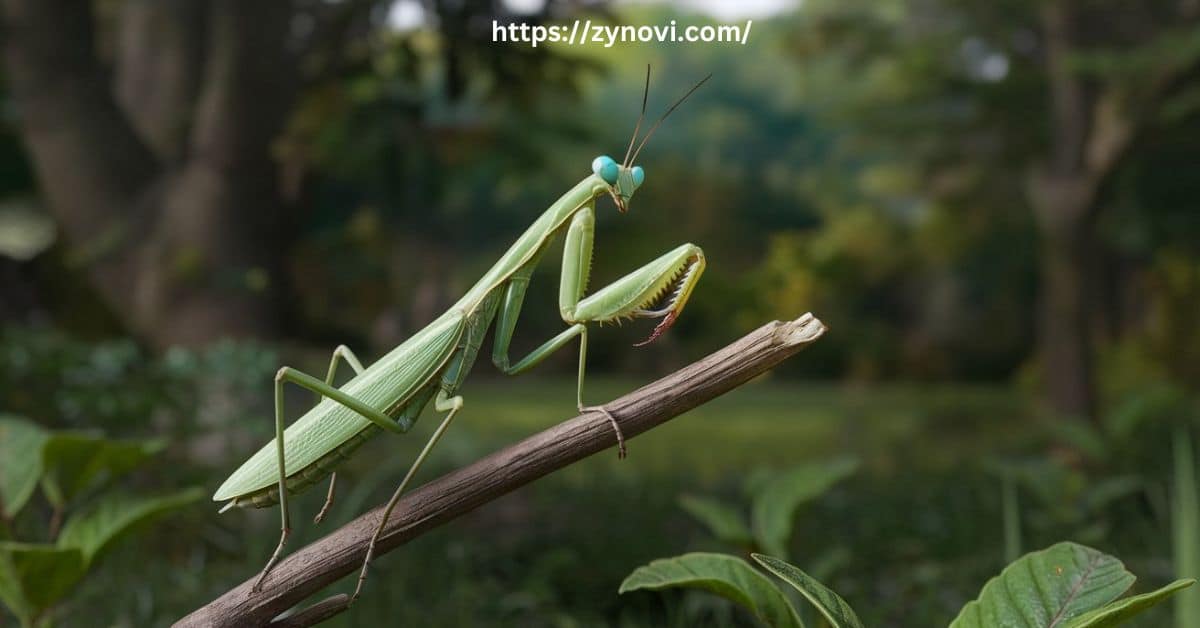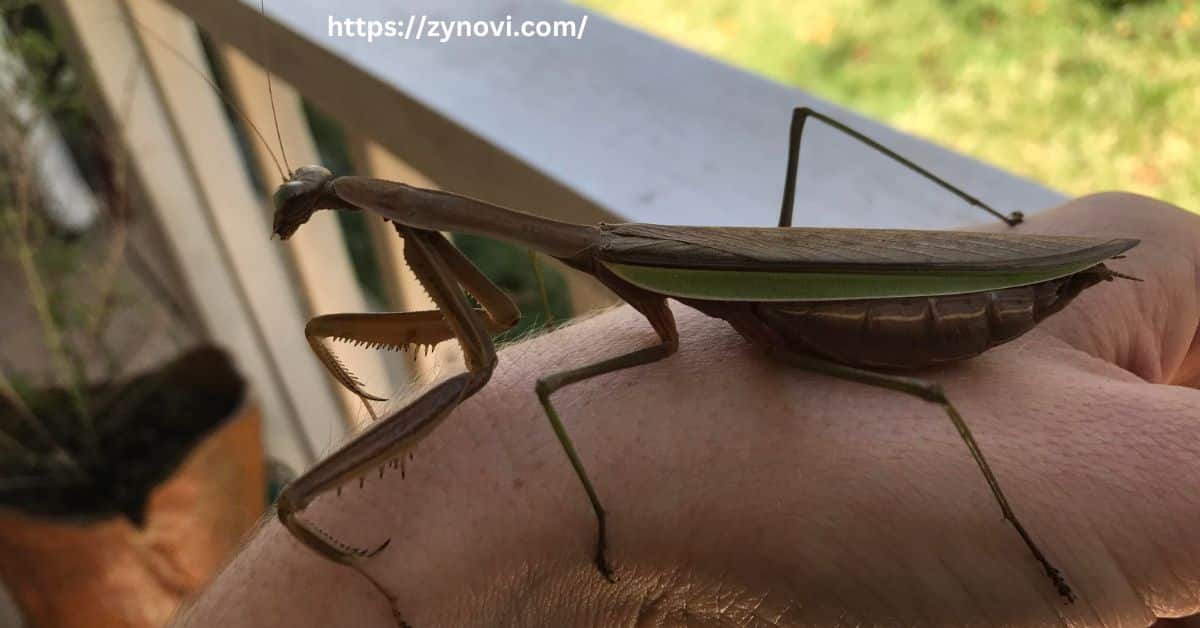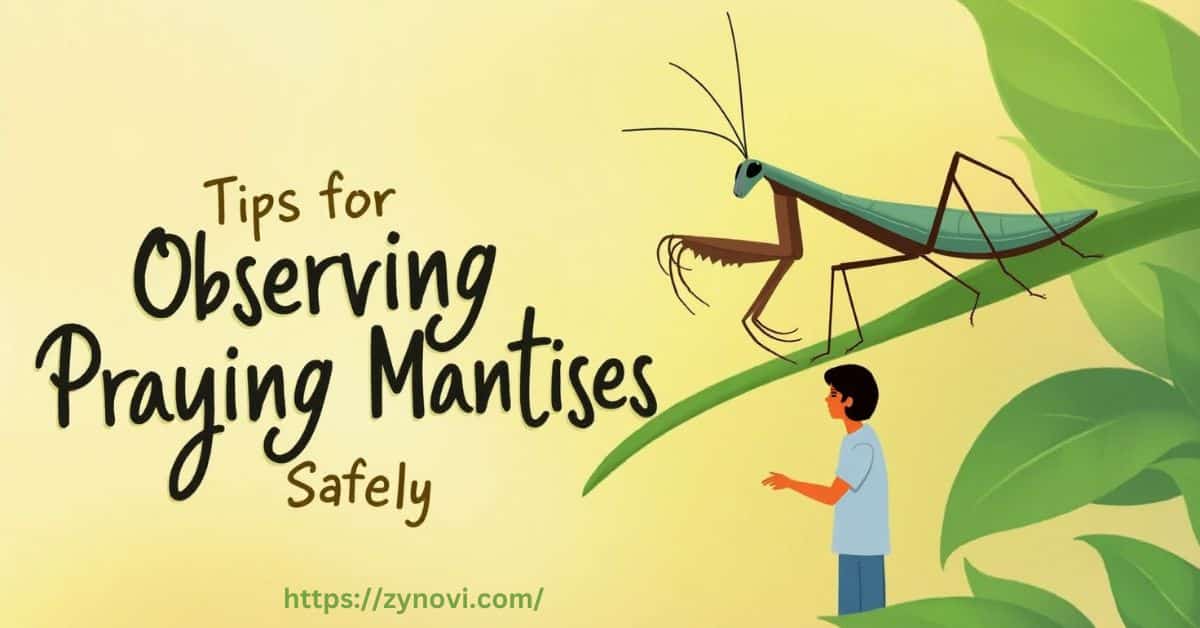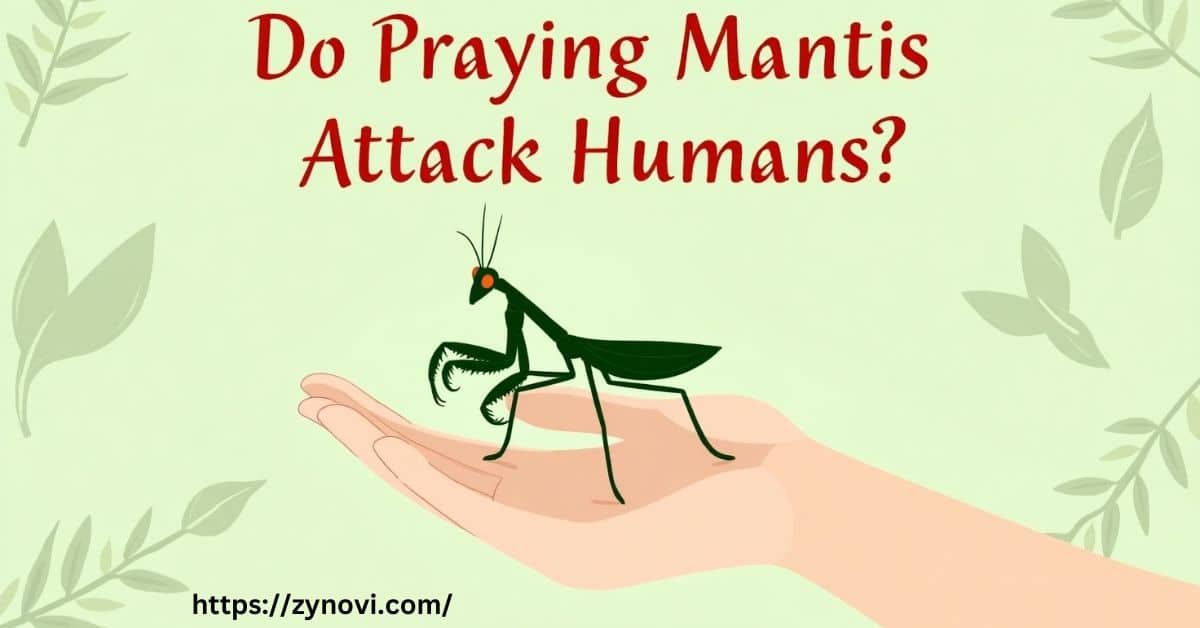Do Praying Mantis Attack Humans? No, They are peaceful creatures that bite only in self-defense if they feel threatened.
You’ve probably seen these fascinating insects perched in your garden, their large, praying like stance making them seem almost otherworldly. But does their striking appearance mean do praying mantis attack humans?
Rest assured, praying mantises are not the threat they might seem. In fact, these incredible creatures are harmless to humans and offer significant ecological benefits.
Let’s find the truth behind their behavior and clear up any misconceptions you might have about these captivating hunters.
What Are Praying Mantises?
Praying mantises are non-aggressive insects that belong to the order Mantodea. With their elongated bodies, triangular heads, and grasping forelegs, they are perfectly adapted to a life of hunting and camouflage. These insects are found in gardens, forests, grasslands, and even urban environments, thriving in both tropical and temperate regions.
Physical Characteristics
| Feature | Description |
|---|---|
| Elongated body | Ideal for blending into foliage. |
| Triangular head | Provides a wide range of vision, thanks to their bulging compound eyes. |
| Grasping forelegs with spines | Used to snatch and secure prey. |
| Camouflage abilities | Many species resemble leaves or twigs, making them nearly invisible to predators and prey. |
Habitats
Praying mantises are highly adaptable and thrive in diverse environments. They can be found in:
- Gardens: Acting as natural pest controllers by hunting aphids, flies, and other harmful insects.
- Forests and grasslands: Blending seamlessly into trees, shrubs, and grasses to ambush prey or evade predators.
- Deserts: Demonstrating resilience by surviving in arid conditions with minimal resources.
- Urban areas: Adapting to human-altered landscapes, often hiding in parks or backyards.
Their ability to camouflage and adapt allows them to inhabit regions ranging from tropical rainforests to temperate zones worldwide.
Do Praying Mantises Interact With Humans?

Praying Mantis Behavior Explained
Praying mantises are primarily sit-and-wait predators, relying on their camouflage and quick reflexes to ambush prey. They exhibit incredible patience, often remaining motionless for extended periods before striking with lightning speed.
Despite their predatory nature, praying mantises are not aggressive toward humans. Their primary focus is on hunting smaller creatures like insects, frogs, and small reptiles.
Human interaction is rare and usually incidental, as these insects prefer to avoid confrontation.
Situations When They Might Bite
Praying mantises rarely bite humans. However, bites can occur in the following situations:
- Handling them: A mantis may bite defensively if it feels threatened.
- Accidental contact: Picking one up unknowingly might provoke a reaction.
These instances are uncommon, and even when they happen, bites are harmless and non-venomous. Praying mantises lack venom or harmful toxins, making them safe to humans.
Does a Praying Mantis Bite Harmful?
Praying mantises possess small mandibles that are capable of piercing the skin, but
- Bites are painless or mildly irritating: Praying mantis bites typically don’t cause significant pain. If a bite occurs, it may feel like a small pinch or a mild irritation, but it’s not generally something that would cause lasting discomfort.
- They pose no risk of venom or disease transmission: Praying mantises do not produce venom, and their bites do not carry diseases that could be transmitted to humans. Therefore, a bite is not harmful in terms of health risks or infection.
Myths and Facts About (Can a Mantis Hurt You?)
Praying Mantises
- Myth: Praying mantises are aggressive and attack humans.
Fact: Praying mantises are not naturally aggressive toward humans. They are primarily defensive creatures and will typically try to avoid confrontation rather than seek it out. They may only strike in self-defense if they feel threatened. - Myth: They are venomous.
Fact: Praying mantises are completely non-venomous. While they can bite if provoked, they do not possess any venom or toxins to harm humans. Their primary method of capturing prey is through their powerful forelegs, not venom.
Documented Cases of Praying Mantis Bites
There are very few documented cases of praying mantis bites, and most of these incidents occur under specific circumstances. These bites are typically the result of individuals deliberately handling the mantis or accidentally provoking it.
Praying mantises are generally peaceful creatures and will only bite in self-defense when they feel threatened or cornered. They do not actively seek out human contact.
In most cases, the bite is a misunderstanding of their defensive behavior, as they may strike if they perceive a threat, but these instances are rare and usually harmless, causing only mild discomfort or irritation.
Do Praying Mantis Attack Dangerous to Humans?

Are Praying Mantises Dangerous to Humans? Praying mantises are not dangerous to humans. They are, in fact, beneficial insects. Their presence should be seen as a positive addition to any garden or natural setting.
Why They Are Harmless:
- Lack venom or harmful substances: Praying mantises do not produce venom or any harmful substances. Their bites are not toxic and pose no danger to human health, making them harmless creatures despite their predatory nature.
- Do not seek out humans as prey: Praying mantises do not view humans as potential prey. They primarily hunt insects and small animals, and humans are not on their radar unless provoked.
- Bite only in self-defense, and bites are non-threatening: Praying mantises will bite only if they feel threatened or cornered, and their bites are not dangerous. These bites rarely cause more than mild irritation and are simply a defensive response.
Why Praying Mantises Are Good to Have Around
Their Role as Natural Pest Control
Praying mantises play a vital role in controlling garden pests. They feed on:
Here’s the information in a table format:
| Pest Controlled | Role of Praying Mantis |
|---|---|
| Aphids | Praying mantises feed on aphids, helping to reduce their population in gardens. |
| Flies | They also consume flies, preventing these pests from overrunning garden spaces. |
| Moths | Moths are another target, as mantises capture and eat them, limiting their numbers. |
| Beetles | Mantises help control beetle populations, especially those that can damage crops and plants. |
Contribution to Biodiversity
They serve as both predators and prey, maintaining balance in ecosystems: Praying mantises play an important role in food chains by acting as both predators and prey.
As predators, they help control insect populations, while they themselves serve as food for birds and larger insects, contributing to a balanced ecosystem.
They act as indicator species, signaling the health of their habitats: Praying mantises are considered indicator species, meaning their presence and health reflect the condition of the environment around them.
A thriving population of mantises often signals a healthy, balanced habitat, while a decline can indicate issues such as pollution or habitat destruction.
Benefits to Agriculture
Praying mantises provide significant benefits to agriculture by naturally controlling pest populations, which reduces the need for chemical pesticides.
By feeding on harmful insects like aphids, beetles, and moths, they help maintain a healthy balance in crops, promoting sustainable farming practices and reducing the environmental impact of pesticide use.
Tips for Observing Praying Mantises Safely

Praying mantises are fascinating to watch, but it’s essential to respect their space.
- Avoid handling them: Stress can lead to defensive behavior: While it may be tempting to hold a praying mantis, handling them can cause stress, making them more likely to bite in self-defense. It’s best to admire them from a distance to prevent distress.
- Observe from a distance: Their hunting techniques are best seen in their natural habitat: Praying mantises are skilled hunters, and observing their hunting techniques in the wild offers a fascinating look at their behavior. Keeping a safe distance allows you to watch them without disturbing their natural activities.
- Create a welcoming environment: Plant shrubs and avoid pesticides to attract them to your garden: To attract praying mantises to your garden, plant shrubs, flowers, and other plants that provide shelter and food. Avoid using pesticides, as they can harm the mantises and other beneficial insects, ensuring a healthy, balanced ecosystem.
Final Verdict: Do Praying Mantis Hurt Humans?
Praying mantises are not a threat to humans and are, in fact, gentle and beneficial creatures. They play an important role in controlling pest populations, making them valuable to both gardens and agriculture.
While their appearance and ability to strike quickly may seem intimidating, they only bite in self-defense when provoked. By understanding their behavior and ecological significance, people can appreciate these fascinating insects without fear.
Embracing their role in nature can promote coexistence and encourage a healthier, more balanced environment for both humans and wildlife.
FAQs
Can a praying mantis bite or harm a human?
While praying mantises can bite if handled, their bites are harmless and do not pose any danger to humans.
What should I do if I encounter a praying mantis?
Stay calm and enjoy observing it. If it lands on you, gently let it crawl onto a nearby surface.
Why are praying mantises beneficial for gardens?
They act as natural pest controllers, feeding on harmful insects and reducing the need for chemical pesticides.
Is it safe to keep a praying mantis as a pet?
Yes, they make unique pets but require specific care, including live prey and a suitable enclosure.
How can I attract praying mantises to my garden?
Plant diverse vegetation, avoid pesticides, and provide natural hiding spots to encourage mantis activity.
Conclusion: Do Praying Mantis Attack Humans?
Praying mantises are truly remarkable creatures that deserve our appreciation and respect. Despite their intimidating appearance, they are harmless to humans and pose no real threat. In fact, they play a vital role in ecosystems by controlling pest populations, which benefits both agriculture and natural habitats.
By gaining a deeper understanding of their behavior and ecological contributions, we can foster a sense of coexistence with these fascinating insects. Embracing their presence not only enriches our knowledge of nature but also promotes a healthier, more balanced environment for all species, including humans.










